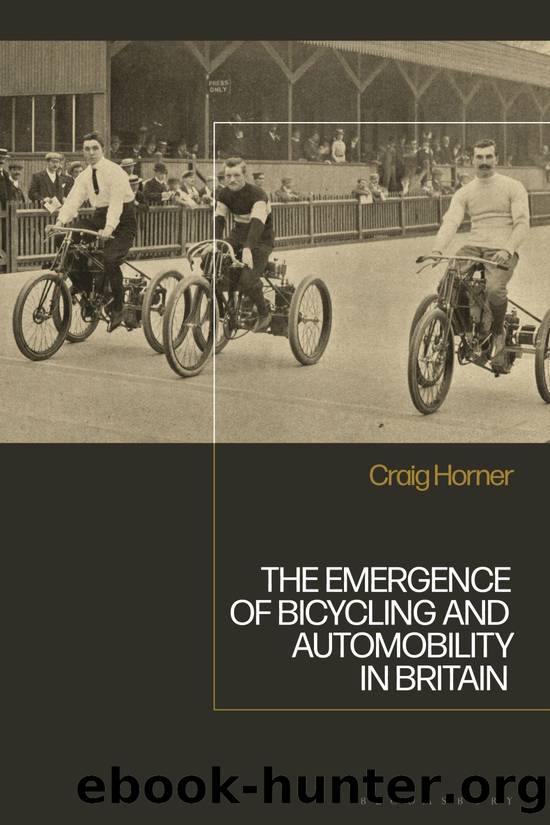The Emergence of Bicycling and Automobility in Britain by Craig Horner

Author:Craig Horner
Language: eng
Format: epub
Publisher: Bloomsbury Publishing Plc
Figure 5.6 The financier Edward Pennington made ludicrous claims in his catalogues, playing on wide public ignorance of the abilities of the new motor traction. Here, in G. N. Martinâs illustration, the âFlying Pennington Cycleâ (1896) is made to leap a ravine of sixty-five feet: From H. O. Duncan, The world on wheels, vol. 2 (Paris: privately pub., 1926), p. 688.
The new consumer was increasingly identified as distinct from the previous world of Jarrottâs âold brigadeâ who increasingly was being recast as a relic of his time. By 1914, motorists thought of themselves as âold timersâ if they had been driving ten years before. The environment had changed so much that Henry Sturmey felt it necessary to suggest âdutiesâ by which the new motorist should abide, such as showing consideration for cyclists and passing horses with care. This was indicative of the new type of motorist: âmost people who drive cars have been [cyclists]â, but âthere are drivers who have never cycledâ,108 he said. âAutomanâ asked what had become of our âfriends of the early days? Where are the Bolleeâs, Benzâs and such like, or the belt-driven cars?â,109 referring to vehicles from the 1890s, few of which were ever available even then. In a review of a book, The Motor wrote that to be a good driver in the old days was to understand the engine and transmission, and the early motorist was a ârare birdâ; that was altered now. The roads are now âfull of swiftly moving trafficâ â âan entirely new set of conditions has arisen which needs special attentionâ.110
The status of the âold brigadeâ was cemented with the setting up of âold timerâ networks, particularly after the First World War. Most notable was the Circle of Nineteenth-Century Motorists, formed in 1927 and open to anyone who could prove they had driven a motor vehicle prior to the Thousand Mile Trial of 1900. About 250 members were elected and participated in grand annual dinners, with, it seems, eyebrow-raising entertainment,111 before declining membership caused it to be wound up in 1960. That it was necessary to have two references, and that each application was scrutinized by the honorary secretary Montague Grahame-White is an indication of the social credit that membership brought.112 Edge was quick to join, and his handwritten notes on many of the application forms shows he was involved closely in the vetting process thereafter. Fellow members included Henry Ford (1863â1947) and Herbert Austin. Open only to men (even guests at the dinners had to be male), this was truly a list of the clubbable. Edge was also in the Fellowship of Old-Time Cyclists, a fraternity of older cyclists who also enjoyed meeting over dinners. Membership was restricted to those born before 1873113 and included many who straddled the cycling and motoring worlds.
Buyers of (new) motor cars were becoming more conscious of style, a prejudice encouraged by entrepreneurs who needed to sell subsequent motor cars to the same customers. Older cars were now referred to as âcrocksâ, compared
Download
This site does not store any files on its server. We only index and link to content provided by other sites. Please contact the content providers to delete copyright contents if any and email us, we'll remove relevant links or contents immediately.
| Automotive | Engineering |
| Transportation |
Whiskies Galore by Ian Buxton(41879)
Introduction to Aircraft Design (Cambridge Aerospace Series) by John P. Fielding(33064)
Small Unmanned Fixed-wing Aircraft Design by Andrew J. Keane Andras Sobester James P. Scanlan & András Sóbester & James P. Scanlan(32743)
Craft Beer for the Homebrewer by Michael Agnew(18140)
Turbulence by E. J. Noyes(7936)
The Complete Stick Figure Physics Tutorials by Allen Sarah(7307)
Kaplan MCAT General Chemistry Review by Kaplan(6867)
The Thirst by Nesbo Jo(6828)
Bad Blood by John Carreyrou(6552)
Modelling of Convective Heat and Mass Transfer in Rotating Flows by Igor V. Shevchuk(6391)
Learning SQL by Alan Beaulieu(6211)
Weapons of Math Destruction by Cathy O'Neil(6146)
Man-made Catastrophes and Risk Information Concealment by Dmitry Chernov & Didier Sornette(5921)
Digital Minimalism by Cal Newport;(5664)
Life 3.0: Being Human in the Age of Artificial Intelligence by Tegmark Max(5474)
iGen by Jean M. Twenge(5366)
Secrets of Antigravity Propulsion: Tesla, UFOs, and Classified Aerospace Technology by Ph.D. Paul A. Laviolette(5309)
Design of Trajectory Optimization Approach for Space Maneuver Vehicle Skip Entry Problems by Runqi Chai & Al Savvaris & Antonios Tsourdos & Senchun Chai(5011)
Pale Blue Dot by Carl Sagan(4912)
